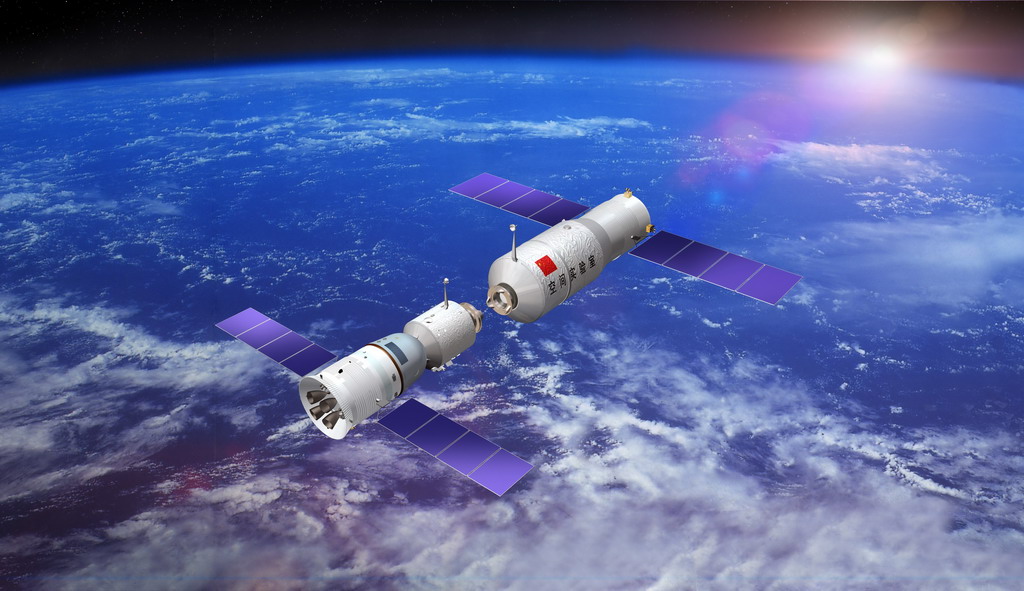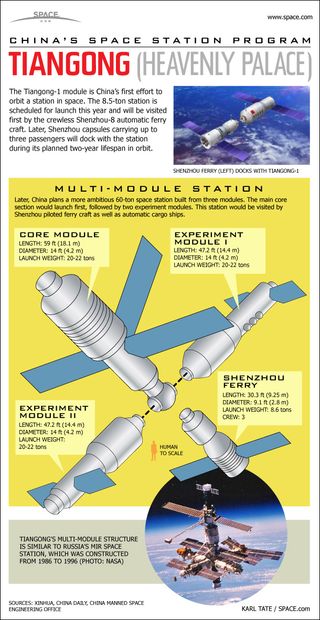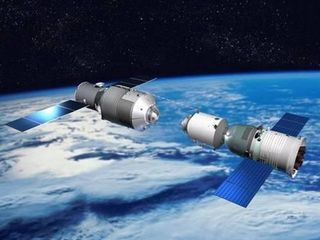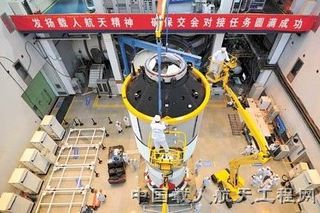China's First Space Station: A New Foothold in Earth Orbit

China's state-run news outlets report that preparations of the country's first space station module, called Tiangong-1, are in full swing for a launch in the second half of this year and will be followed by an unpiloted spacecraft.
The spacecraft twosome, the station module and China's Shenzhou 8 vehicle, will mark the country's first round of orbital rendezvous and docking tests – viewed as a springboard to larger space adventures. A Long March 2F rocket is the booster of choice for the individual launches, according to reports by China's Xinhua news agency. [Photos: China's First Space Station]

According to state media reports, the Tiangong-1 space station module is outfitted with a docking port on its front and rear ends. It will tip the scales at roughly 8 1/2 tons and purportedly will have a two-year lifetime in Earth orbit.
Next year, China's Shenzhou 9 and Shenzhou 10 missions, each carrying astronauts, are expected to link up with the station module, according to current plan.
By honing their skills at rendezvous and docking, Chinese space officials see the target practice as a step forward in assembling a far heftier space facility, now slated to be completed around 2020, according to Yang Liwei, deputy head of China’s Manned Space Engineering Office. Yang was China’s first person to orbit the Earth, in 2003.
China currently has a 21-member astronaut corps that includes two women and is undergoing training for future docking and rendezvous milestones. The two women are pilots drawn from the People's Liberation Army Air Force.

Larger space station
Get the Space.com Newsletter
Breaking space news, the latest updates on rocket launches, skywatching events and more!
According to an April 26 Xinhua report, China's goal is to build a 60-ton space station that would consist of three modules and also would make use of a cargo spaceship delivering supplies to the orbital complex.
The full-size station would have a 59-foot (18.1-meter) core module with a maximum diameter of 14 feet (4.2 meters) and a launch weight of between 20 and 22 tons (18,100 to 19,900 kilograms). That central module would be launched first, according to the plan. [How China's First Space Station Will Work (Infographic)]
The two follow-on laboratory modules would each be 47 feet long (14.4 meters), with the same maximum diameter and launch weight of the core module.
Details of the station construction job were outlined in a press meeting held April 25 by the China Manned Space Engineering Office.
Wang Wenbao, director of the CMSEO, recently called upon Chinese people around the world for a logo and a distinctive name for the country’s first crewed space station.
Chinese media reports also state Wang has requested ideas and logo concepts for the space station to be sent to an organizing committee via online polls that will run over next several months.

China's Skylab
Call it "China's Skylab," said Gregory Kulacki, senior analyst and China project manager for the global security program at the Union of Concerned Scientists. Skylab was the name of the first American space station launched by NASA.
"The 60-ton Chinese station is approximately the same size as America's first space station and is being launched at a comparable stage in the history of China's human space flight program," Kulacki told SPACE.com.
NASA's Skylab was lofted back in 1973. It was visited by a trio of crews, three astronauts each time.
The last team to visit that U.S. station set a world record at the time for longest stay in orbit, 84 days. The 100-ton facility re-entered Earth’s atmosphere in 1979.
High hopes
China’s goal for the program, Kulacki said, is equally simple: to acquire experience living and working in space.
"The planned scientific and technical experiments will be informed by developments in space science since the late 1970s," he added, "and China has high hopes that their experience in space will lead to breakthroughs that can be applied back on Earth."
Domestic proponents of China’s human spaceflight program argue that America's program -- which served as a model for the Chinese -- stimulated U.S. technical and economic development, Kulacki noted. "The Chinese political leaders funding the program hope they are right."
Kulacki said that Chinese opponents who question the diversion of the country's still limited human, technical and financial resources to human spaceflight argue that China is simply repeating what was accomplished decades ago, by the United States.
"Moreover there is no evidence that China's accomplishments in human spaceflight provide increased political legitimacy or support for the Chinese Communist Party, despite the expansive propaganda efforts surrounding the program,” Kulacki advised.
Another take on what's in the offing from China comes from Dean Cheng, a Research Fellow at the Heritage Foundation’s Asian Studies Center – and a specialist in China's military and space capabilities.
Cheng said China’s moves to deploy a space lab are a continuation of its Project 921, begun in 1992.
"It reflects the long-term nature of China's space planning and underscores the persistent and consistent nature of their space efforts," Cheng said. "Nearly 20 years after the plan was first set in motion, the Chinese are still at it, in a slow, methodical fashion."
Moreover, Cheng noted that the Chinese do not see themselves in a race with the United States. Or, if they do, it is a marathon, not a sprint.
"They are operating according to their timelines, not in response to American efforts or out of fear that they will be left behind by the United States," Cheng said.
Such an approach has the potential of creating a "frog in the pot" effect for the United States, Cheng said.
"The slow, persistent Chinese approach ensures that there is not a 'Shenzhou moment' comparable to a 'Sputnik moment'… until the Chinese do make a major breakthrough ? at which point, it is an open question whether they [the U.S.] will be able to catch up or not."
Military implications
Cheng sees potential military implications from the imminent testing of rendezvous and docking know-how by China.
"Not so much in terms of manned military missions … Rather, rendezvous and docking skills can be transferred to unmanned spacecraft, whether it is for kinetic kill operations or inspection of foreign satellites -- say, for intelligence or war-fighting purposes or other malign purposes," Cheng said.
All of this underscores why repeated attempts by the U.S. to ignite cooperation in the area of manned space are unlikely to bear fruit, Cheng said, "but likely to result in catastrophe."
That is, if there is a failure in the cooperation (not technical failure, but failure of political will, or failure of political steadfastness to see things through), then it will have enormous repercussions, which would be bad for the larger Sino-US relationship, Cheng added.
Cheng said that the Chinese are explicitly following a policy of "indigenous innovation" -- a heavy emphasis on self-reliance.
"China's space program is largely home-grown and a point of pride to the Chinese," he added. "Why should they cooperate with the U.S.? What is in it for them … especially in light of the export control regulations aimed at China?"
Winner of this year’s National Space Club Press Award, Leonard David has been reporting on the space industry for more than five decades. He is past editor-in-chief of the National Space Society’s Ad Astra and Space World magazines and has written for SPACE.com since 1999.
Join our Space Forums to keep talking space on the latest missions, night sky and more! And if you have a news tip, correction or comment, let us know at: community@space.com.

Leonard David is an award-winning space journalist who has been reporting on space activities for more than 50 years. Currently writing as Space.com's Space Insider Columnist among his other projects, Leonard has authored numerous books on space exploration, Mars missions and more, with his latest being "Moon Rush: The New Space Race" published in 2019 by National Geographic. He also wrote "Mars: Our Future on the Red Planet" released in 2016 by National Geographic. Leonard has served as a correspondent for SpaceNews, Scientific American and Aerospace America for the AIAA. He has received many awards, including the first Ordway Award for Sustained Excellence in Spaceflight History in 2015 at the AAS Wernher von Braun Memorial Symposium. You can find out Leonard's latest project at his website and on Twitter.
Most Popular

